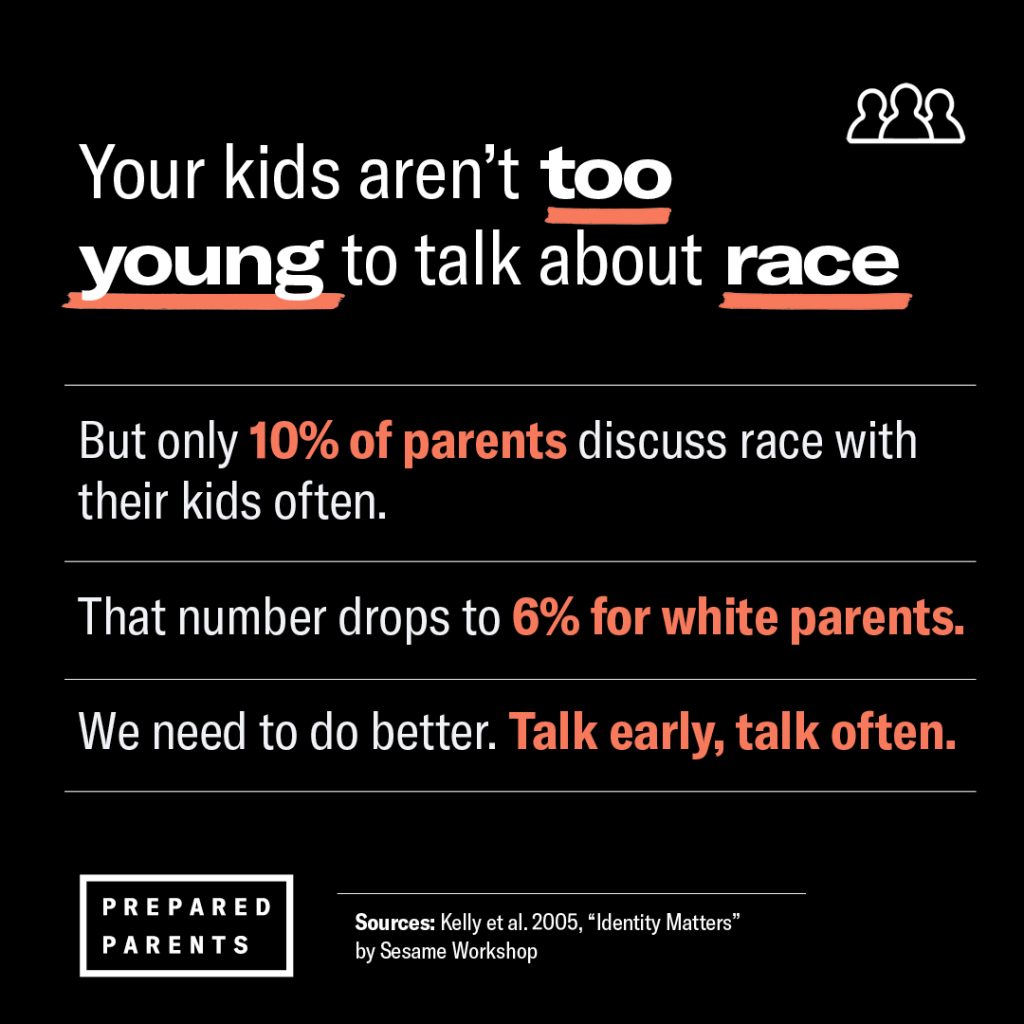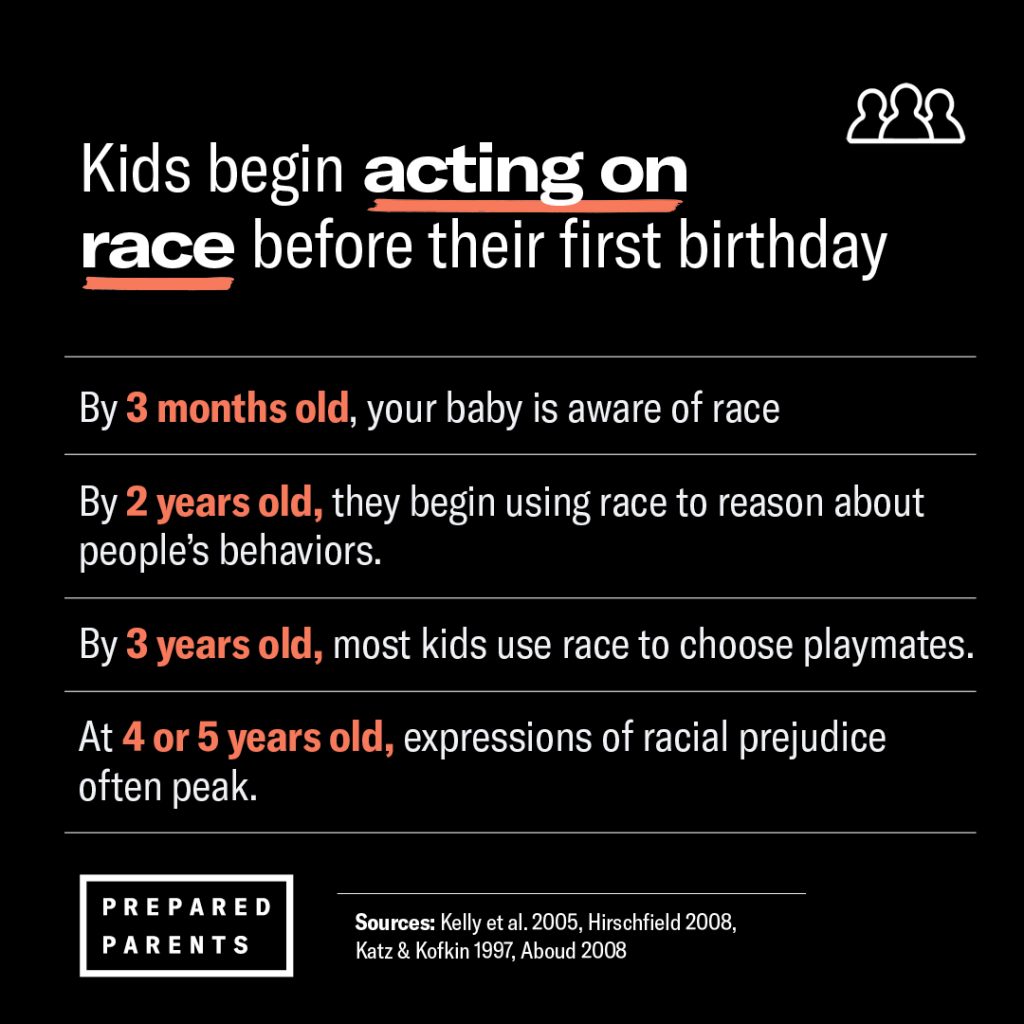Only ten percent of parents often discuss race with their kids; with only six percent of white parents having the conversation. This trend plays out in schools as well. And yet, by 2060, 75% of the U.S. population will be multi-racial and/or multi-ethnic, according to the U.S. Census Bureau.
Too few of our kids understand the history of our country’s structural and systemic racism, or contemplate the ongoing violence and bias faced by people of color in America today. As parents, we have an obligation not only to talk to kids about race, but also to take action to combat systemic racism and violence consistently and routinely. Talking to our kids is just the beginning. Addressing racism combines the head and the heart. First, we gain knowledge and then we practice compassion, empathy, and respect.

Often, parents don’t talk to their kids about race because we think that if we do, we’ll introduce racial bias and create racist children. The truth is, if we don’t talk to them about race, kids will draw their own conclusions based on what they see. Educating our kids about race teaches them that differences are normal. Let’s get off the sidelines and teach our kids to be an advocate and stand up for friends, classmates, and family members who may feel the sting of racism.
How kids respond to race follows some of their developmental milestones. Kids recognize racial identity early, so parents can help them develop positive attitudes about diversity beginning in infancy.
- As early as 3 months, a baby’s brain can notice race-based differences.
- At ages 2 to 4, children can internalize racial bias.
- By age 12, many children become set in their beliefs—giving parents a decade to mold the learning process, so that it decreases racial bias and improves cultural understanding.

The uptick in hate crimes and racial violence happening right now is disturbing and incomprehensible. As parents, our thoughtful response can help our kids process what’s been happening while helping them to deepen their understanding of race, identity, and acceptance. To lead our kids towards a clearer understanding of race and identity, we can start by taking these steps:
Understand our history.
Systemic racism is woven into the fabric of life in America. It traces back four hundred years. Adults often teach the historical perspective pointing to heroes like Martin Luther King, Rosa Parks, and other civil rights activists. It’s easy to say, this is how it used to be.
“If we teach children that racism is simply a thing of the past, and that today we are all equal, children may mistakenly assume that the unequal racial patterns they see are earned or justified.”
-Dr. Erin Winkler, Associate Professor at University of Wisconsin-Milwaukee
If you’re uncomfortable talking about this because you don’t know the facts, educate yourself. Access books and resources to get perspective on how deeply seeded the issue is. Reach out to individuals you may know who have experienced discrimination and racial inequity and have those difficult conversations about what it feels like.
Rethink our own behavior.
Are we unknowingly practicing passive racism? Every person has biases acquired through socialization, upbringing, education, and media. Dr. Margaret Hagerman, author of White Kids: Growing up with Privilege in a Racially Divided America, says, “Parents may not even be aware that they are conveying ideas about race through their behaviors.”
Choices we make about where to live, what activities to participate in, and what to talk about all influence a kid’s perspective on race. Dr. Hagerman points to other less conscious acts that have an impact, like how we react to news reports, what books and magazines we read, who comes to the house for dinner, and how we respond to divisive remarks made by others.
Watch our words and theirs.
Be aware of how you and your kid speak. If they say something inappropriate or insensitive, check yourself first. Did they hear it from you? Ask why they chose a term and talk about what it really means before helping them choose better words next time.
If their comments point to stereotypes, find ways to disprove them. Ask your kid to do a little digging to learn how these stereotypes developed and why people believe them. Conversation and research are opportunities to not only develop your kid’s acceptance and respect of others, but to dispel myths and misconceptions.
If you notice an objectionable comment, a racist characterization, or other racist remark in a movie or TV show, point it out. You’ll help your kid develop sensitivity and critical thinking skills.
Start the conversation.
Don’t shy away from the conversation about structural racism, racial violence, implicit bias and differences. Initiate it and lean in to the tough questions.
- Use the concept of “fairness.”
Erin Winker, author of Here’s How To Raise Race-Conscious Children, tells us that young kids have a natural sense of justice and are attuned to seeing patterns in the world around them. Because of this, unfairness is the perfect way to explain and conceptualize racism to young children. - If you’re not sure how to start, tell a story or read a multi-cultural book.
There’s power in storytelling. Listening to a story helps kids focus, remember information, develop empathy, and navigate some of life’s challenges. Use the stories as prompts to go further with probing questions. Ask your kid to put themselves in the character’s shoes and ask, how do you think that experience would have made you feel? - Because they’re naturally curious, kids may ask difficult questions regarding race.
How we answer teaches them respectful curiosity. If you don’t have an appropriate answer, wait a minute. It’s OK not to know what to say. Validate their questions and return to them later once you’ve had time to consider how to respond. Or, say, “I’m not sure. Let’s look into it and learn about it together.”
Don’t conclude by saying, “we’re all the same on the inside.” Challenge that. Our biological systems may be the same, but how we are treated is different. Discuss the implications of race.
How does it impact people’s feelings of security and freedom?
How does it impact where a family may live and work?
What opportunities do they have based on how they look?
What stereotypes do people face?
How are they treated differently by other citizens or by societal structures?
Make more friends.
It’s not enough to say diversity is important. We need to model it with our friendships. A study confirmed that kids’ attitudes towards race are more highly influenced by the racial makeup of their parents’ friend group, than by their parents’ messages around race. And for kids, research says cross-race friendships decrease prejudice and increase empathy. More time together broadens the idea of inclusiveness. We can step out as allies for our friends socially, but just as importantly, show up as allies for our colleagues at work. The best way to broaden our kid’s horizons when it comes to race is to model how we’d like kids to behave, ourselves.
Broaden horizons.
Make an intention to step out into the broader community on a regular basis once everything opens up again. Attend cultural fairs, museum exhibits, and social gatherings. Spend family time in different neighborhoods to give your kid a better view of how varied your community is. There are many reasons ethnic groups choose to live in specific geographic areas—shared language, customs, friends and relatives. Embrace the unfamiliar by eating in a restaurant, shopping in a
store or grocery, and meeting with neighborhood families in local parks and playgrounds.
Celebrate differences.
Acknowledge and admire differences. Otherwise you may send the message that being different is bad. When your kid asks about skin color, style of dress, or language, respond with positive open-ended questions, like “Isn’t that fabric beautiful? I wonder where that style of dress comes from?” Or, “Isn’t it interesting to see so many different skin shades. Do you know why we have different skin tones?”
Expose your kids to diverse cultures to broaden their horizons and break down prejudice and bias. But don’t be a cultural tourist. Instead, interact across cultural and racial lines to truly expand your kid’s world. This also builds self-awareness.
Diversify the toy box.
Kids learn through play. It’s when they improvise, experiment, and make things up. Adding a more diverse selection of action figures, dolls, and other playthings to their collection enables them to practice interactions across racial and cultural lines. It also reflects a more realistic perspective on our society’s makeup. Plus it’s important for kids to see themselves reflected in their toys.
Build a library of diverse literature and read the books together.
Give your kid access to books and videos that will bolster their knowledge of race and identity. Actively seek out media that addresses prejudice and inequality, and discuss these with your kid. Let your kid choose the books to read; they’ll be more motivated and read more. Check out the resource list below for suggested titles and other helpful information.
Commit to taking action.
Developing racial awareness in kids is not enough. Consider ways your family can do something. Here are some activities for kids that promote social justice.
- Teach your kid to be an advocate and stand up for friends and classmates who may feel the sting of racism.
- Vote! Make sure your voice is heard through both national and local elections. And, take your kids along when you go to vote (or sit beside them when filling in your mail-in ballot).
- Sign, or start, a petition to encourage change.
- Attend a peaceful protest together to show our kids how to use our voice for change.
- Donate to an organization or group whose values and work you support.
- Have hard conversations and spread the word about injustice and racism with your friends, family, and community.
- Anti-racism resources: This comprehensive resource list includes organizations, media, books, and suggestions on what to do to address racism.
- The Center for Racial Justice in Education offers a resource list for talking to kids about racism and racial violence.
- Common Sense Media has curated a list Coretta Scott King Book Award winners for preschoolers to adolescents.
- The Conscious Kid is an education, research and policy organization dedicated to reducing bias and promoting positive identity development in youth.
- Colours of Us curates a list of multicultural books, toys, activities, and clothes.
- Beyond the Golden Rule is a free digital book created by TeachingTolerance that emphasizes an age appropriate response to social justice and anti-bias.
- Parent Toolkit article: How to talk to your kids about race and racism.

